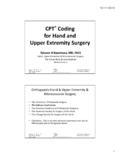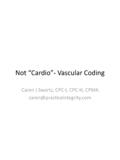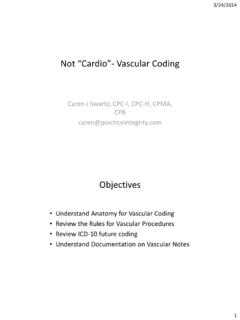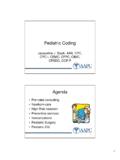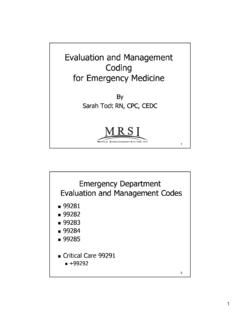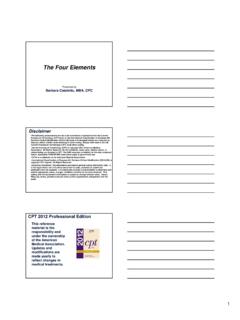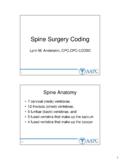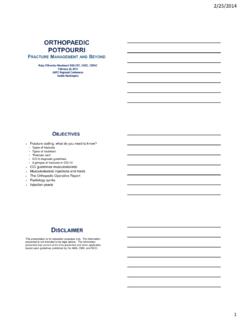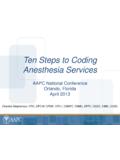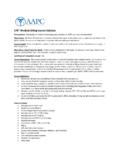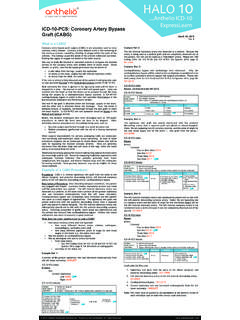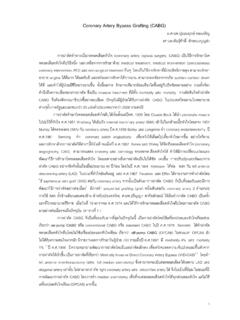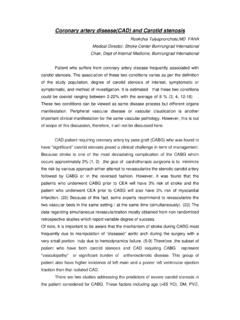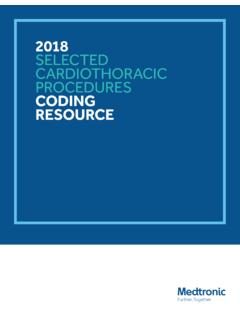Transcription of 4A-Have a Heart Cardiology Coding - AAPC
1 10/10/20121 have a Heart : Cardiology CodingAAPC Regional ConferenceOctober 25-27, 2012 ChicagoPresented by: Betty A Hovey, CPC, CPMA, CPC-I, CPC-H, CPCDD irector, ICD-10 Development and TrainingAAPCA genda Anatomy of the Heart Cardiovascular diseases Common Cardiology ICD 9 CM codes CABG Valve procedures Pacemakers and defibrillators10/10/20122 ElectrocardiogramWe ve come a looooooooong way310/10/20123 Chambers and valvesOxygenation Process1. Deoxygenated blood enters into right atrium through superior or inferior vena cava2. Tricuspid valve opens and blood drops into right ventricle3. Pulmonary valve opens, and deoxygenated blood moves through it into pulmonary artery4. Pulmonary artery sends the blood to the lungs where oxygenation occurs at the capillary beds5.
2 Oxygenated blood enters back into left atrium through l6pulmonary vein 6. Mitral valve opens and blood drops into left ventricle7. Aortic valve opens and ventricular muscle pumps blood up and out into the body through the aorta10/10/20124710/10/20125 coronary Heart DiseaseChtdi(CHD)iifth Coronaryheartdisease(CHD)isanarrowing ofthesmall blood vessels that supply blood and oxygen tothe Heart . CHD is also called coronary artery disease(CAD).Cdiihldifdh coronary artery disease is the leading cause of death in the United States for men and Heart DiseaseSymptoms Chest pain or discomfort (angina) (most common) Chest heaviness/ Squeezing Pain usually occurs with activity or emotion, and goes away with rest / nitroglycerin.
3 Shortnessofbreath Shortness of breath Fatigue with exertion1010/10/20126 Baseline US age-standardized death rates from cardiovascular diseases, 2006. Roger V L et al. Circulation 2011;123:e18-e209 Copyright American Heart AssociationPercentage breakdown of deaths due to cardiovascular disease (United States: 2007). Roger V L et al. Circulation 2011;123:e18-e209 Copyright American Heart Association10/10/20127 CAD ICD 9 CM coronary atherosclerosis of unspecified type of vessel, native or graft of native coronary artery of autologous vein bypass graft of nonautologous biological bypass graft of artery bypass graft of unspecified type of bypass graftpypypg of native coronary artery of transplanted Heart of bypass graft of transplanted Heart Angina ICD 9 CM Intermediate coronary syndrome Angina decubitus Prinzmetal angina Other and unspecified angina pectoris10/10/20128 Myocardial InfarctionICD 9 CM Code consideration.
4 Acute/Chronic/Old Specific site STEMI or NSTEMI Episode of careHeart Failure ICD 9 CM Congestive Heart failure, unspecified Left Heart failure Systolic Heart failure Diastolic Heart failure Combined systolic and diastolic Heart failure failure, unspecified10/10/20129 Valve Disorders Considerations for codes Valve(s) affected Type of disorder RheumaticRheumaticValve DisordersRheumatic Rheumatic mitral Not specified as rheumatic Mitral valve disordersstenosis Rheumatic aortic insufficiency Rheumatic diseases of pulmonary valve 397 0 Diseaseoftricuspid Aortic valve disorders Tricuspid valve Disease of tricuspid valve Pulmonary valve disorders10/10/201210 Valve DisorderDisease of mitral and aortic (whether specified asrheumaticornot)as rheumatic or not)
5 Mitral valve stenosis and aortic valve Mitral valve stenosis and aortic valve Mitral valve insufficiency and aortic valve Mitral valve insufficiency and aortic valve insufficiencyConduction Disorder Considerations for codes Complete Type Right Left RightandLeftRight and Left Other10/10/201211 Conduction Disorders Atrioventricular block, complete 426 First degree atrioventricularblock Mobitz (type) II atrioventricular block Left bundle branch block Right bundle branch block 426 51 Rightbundlebranchblockandleft Right bundle branch block and left posterior fasicular blockCABGCORONARYARTERYBYPASSBJ&A, 2009. ALL RIGHTS Coding (33510 33536)From a Coding perspective, the important issues for thecodertoknowarethefollowing:the coder to know are the following: How many grafts were performed?
6 How many were arterial? How many were venous? What was used to perform the graft (s)? Radial artery , hisaphenous vein, etc. Did the patient have a previous CABG procedure performed?CABGThe number and type of graft holds a direct correlation to the CPT code(s) that will be a patient has only venous grafting performed the following code range is applicable:33510 33516 Venous Grafting ONLYfor coronary artery Bypass If a patient has only arterial grafting performed the pyggpfollowing code range is applicable:33533 33536 Arterial Grafting for coronary artery Bypass10/10/201213 CABGIf a patient has both arterial and venous grafting performedthentwocodesmustbereportedfromp erformed then two codes must be reported from the following code ranges:33517 33523 Venous Grafting for Combination coronary artery Bypass Note.
7 These are add on codesAND33533 33536 Arterial Grafting for coronary artery BypassCABGEXAMPLESP atienthasa3venousonlyCABGP atient has a 3 venous onlyCABG33512 Patient has a 2 arterial onlyCABG33534 Patient has a 3 venous, 2 arterialCABG33534, 3351910/10/201214 CABGP rocurement of the Conduit When it is bundled When it is not bundled 35600 UEA 35500 UEV 35572 Fem pop35572 Fempop 33508 Endo harvestCABG Re do If a patient has had a prior CABG, the coder must be aware of an additional code. The procedure would be coded as if it was being performed for the first time, but then add on code 33530, Reoperation, coronary artery by pass procedure or valve procedure, more than one month after the original procedure,morethanonemonthaftertheorigin aloperation, would be reported also.
8 10/10/201215 Valve Disease/Disorder Congenital valve disease Bicuspid aortic valve disease Acquired valve disease Mitral valve prolapse (MVP)Valve Repair/ReplacementA prosthetic (artificial) Heart valve is a replacement for adiseased or dysfunctional Heart valve. There are twotypes ofartificial valves: Mechanical Heart valveA mechanical Heart valve is made of man made materials. The advantage of mechanical valves is that they can usually last a lifetime. They do not wear out thtlbi l i lldthe way natural or biological valves Repair/Replacement Biological Heart valveBiological Heart valves are made from tissue taken from animals or human cadavers. They are treated with preservatives and sterilized for human implantation.
9 BJ&A, 2010. ALL RIGHTS Edwards Silastic ball valve mitral Model 61203210/10/201217 Medtronic Hall mitral valve33St. Jude Medical mechanical Heart valveBJ&A, 2010. ALL RIGHTS Repair/ReplacementThe four key types of biological valve replacements are: Pig valves which are actual transplants from the Heart of a pig. Cow valves which are made from the pericardial tissue of a cow s Heart . Homografts which are human donor Autografts which are the patient s own valve used in the Ross Edwards Mitral Valve3610/10/20121937 Valve Repair/ReplacementCPT codes will depend on the following: Whichvalve? Which valve? Repair or replace? Replaced with prosthetic? Type? Was patient on cardiopulmonary bypass?10/10/201220 Valve Repair/ReplacementAortic Valve Procedures33400 33417 Mitral Valve Procedures33420 33430 Tricuspid Valve Procedures33460 33468 PulmonaryValveProcedures3347033478 Pulmonary Valve Procedures33470 33478BJ&A, 2010.
10 ALL RIGHTS 33405 PROCEDURES: Aortic valve replacement using a mechanical valveINCISION: Median sternotomyINDICATIONS: The patient presented with severe congestive Heart failure associated with the patient's severe diabetes. The patient was found to have moderately stenotic aortic ldddfllvalve. It was decided to perform a valve : The left ventricle is certainly hypertrophied The aortic valve leaflet is calcified and a severe restrictive leaflet motion. It is a tricuspid type of valve. PROCEDURE: The patient was brought to the operating room and placed in supine position. A median sternotomy incision was carried out. The patient weighs nearly three hundred pounds. The patient went on cardiopulmonary bypass and the aortic cross clamp was applied Cardioplegiawasdeliveredthroughthecorona rysinusesinaretrogrademannerTheCardiople giawas delivered through the coronary sinuses in a retrograde manner.
